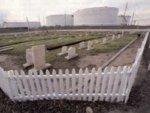Bayonne Energy Center
Bayonne Energy Center is a power plant on Constable Hook in Bayonne, New Jersey originally built as a joint venture between Hess Corporation and ArcLight Capital Partners. it is operated by EthosEnergy.The 644-megawatt natural gas-fired plant came on line in 2012. It connects to a 6.5 mile, 345-kilovolt power line under the Upper New York Bay connecting with a Consolidated Edison substation in Gowanus in Brooklyn, New York which is the longest XLPE cable in the world.The submarine cable portion of the project is one of the most deeply buried submarine cables at 15 feet below New Jersey-New York Harbor bottom. On behalf of the Project, regulator permit applications were prepared and submitted to the New York State Department of Public Service (Article VII), the US Army Corps of Engineers New York District (Sections 10/404), the New York Department of Environmental Conservation, the New York Department of State, and the New York Office of General Services.In 2014, Hess relinquished it interest in the plant to ArcLight. which later sold it to Macquarie Infrastructure Company
Excerpt from the Wikipedia article Bayonne Energy Center (License: CC BY-SA 3.0, Authors).Bayonne Energy Center
New Hook Access Road,
Geographical coordinates (GPS) Address Nearby Places Show on map
Geographical coordinates (GPS)
| Latitude | Longitude |
|---|---|
| N 40.655023 ° | E -74.094267 ° |
Address
New Hook Access Road
New Hook Access Road
07002
New Jersey, United States
Open on Google Maps









